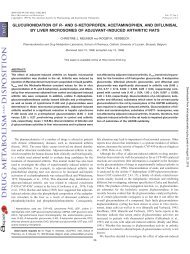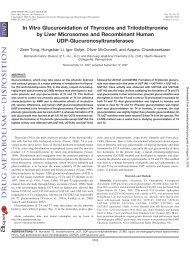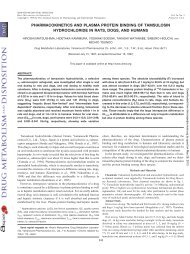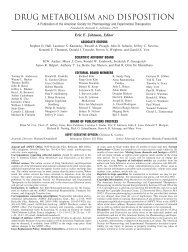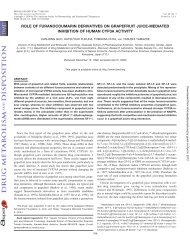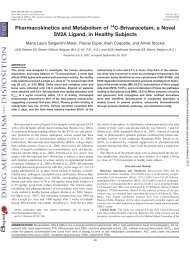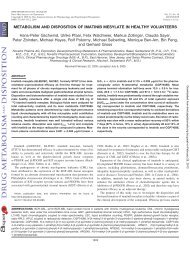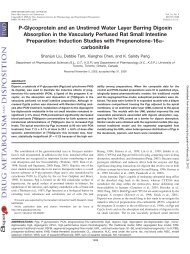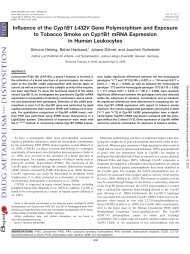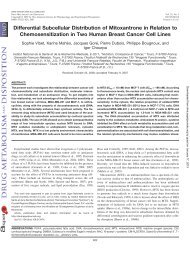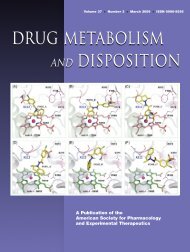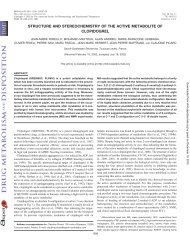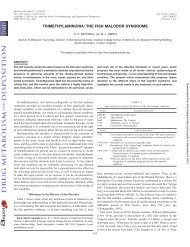development of an in vitro screening model for the biosynthesis of ...
development of an in vitro screening model for the biosynthesis of ...
development of an in vitro screening model for the biosynthesis of ...
Create successful ePaper yourself
Turn your PDF publications into a flip-book with our unique Google optimized e-Paper software.
0090-9556/02/3004-404–413$7.00<br />
DRUG METABOLISM AND DISPOSITION Vol. 30, No. 4<br />
Copyright © 2002 by The Americ<strong>an</strong> Society <strong>for</strong> Pharmacology <strong>an</strong>d Experimental Therapeutics 608/969724<br />
DMD 30:404–413, 2002 Pr<strong>in</strong>ted <strong>in</strong> U.S.A.<br />
DEVELOPMENT OF AN IN VITRO SCREENING MODEL FOR THE BIOSYNTHESIS OF<br />
ACYL GLUCURONIDE METABOLITES AND THE ASSESSMENT OF THEIR REACTIVITY<br />
TOWARD HUMAN SERUM ALBUMIN<br />
SEBASTIEN BOLZE, NORBERT BROMET, CROISINE GAY-FEUTRY, FREDERIC MASSIERE, ROSELYNE BOULIEU,<br />
AND THIERRY HULOT<br />
Department <strong>of</strong> Pharmacok<strong>in</strong>etics <strong>an</strong>d Metabolism, Lipha S.A., Centre de Recherche Lyon-Lacassagne, Lyon, Fr<strong>an</strong>ce (S.B., T.H.); Biotec<br />
Centre, Orle<strong>an</strong>s, Fr<strong>an</strong>ce (N.B.); Biopredic International, Rennes, Fr<strong>an</strong>ce (C.G.F., F.M.); <strong>an</strong>d Département de Pharmacie Cl<strong>in</strong>ique, de<br />
Pharmacoc<strong>in</strong>étique et Évaluation des Médicaments, Faculté de Pharmacie, Université Lyon, Fr<strong>an</strong>ce (R.B.)<br />
ABSTRACT:<br />
An <strong>in</strong> <strong>vitro</strong> screen<strong>in</strong>g <strong>model</strong> was developed to determ<strong>in</strong>e <strong>the</strong> reactivity<br />
<strong>of</strong> acyl glucuronide metabolites from carboxylic drugs. This<br />
assay is composed <strong>of</strong> two phases. The first is a phase <strong>of</strong> biosyn<strong>the</strong>sis<br />
<strong>of</strong> acyl glucuronides by hum<strong>an</strong> liver microsomes (HLM). The<br />
second, dur<strong>in</strong>g which acyl glucuronides are <strong>in</strong>cubated with hum<strong>an</strong><br />
serum album<strong>in</strong> (HSA), consists <strong>of</strong> assess<strong>in</strong>g <strong>the</strong> reactivity <strong>of</strong> acyl<br />
glucuronides toward HSA. Both phases are per<strong>for</strong>med successively<br />
<strong>in</strong> <strong>the</strong> same experiment. This <strong>model</strong> was validated us<strong>in</strong>g<br />
eight carboxylic drugs that were well known <strong>for</strong> <strong>the</strong>ir reactivity,<br />
<strong>the</strong>ir extent <strong>of</strong> covalent b<strong>in</strong>d<strong>in</strong>g, <strong>an</strong>d <strong>the</strong>ir immunological potential.<br />
These products were representative <strong>of</strong> <strong>the</strong> scale <strong>of</strong> reactivity. Each<br />
compound was <strong>in</strong>cubated with HLM at 400 M <strong>an</strong>d metabolized<br />
<strong>in</strong>to acyl glucuronide to different extents, r<strong>an</strong>g<strong>in</strong>g from 5.6% (tol-<br />
M<strong>an</strong>y acidic drugs with carboxylic acid functions are metabolized<br />
to reactive acyl glucuronides. These metabolites are unstable at physiological<br />
pH <strong>an</strong>d c<strong>an</strong> result <strong>in</strong> free aglycone by hydrolysis <strong>an</strong>d lead to<br />
positional isomers by acyl migration. Acyl migration <strong>in</strong>volves <strong>the</strong><br />
tr<strong>an</strong>sfer <strong>of</strong> <strong>the</strong> acyl group from <strong>the</strong> position 1 to <strong>the</strong> C-2, C-3, or C-4<br />
position <strong>of</strong> <strong>the</strong> glucuronic acid r<strong>in</strong>g, which results <strong>in</strong> <strong>the</strong> <strong>for</strong>mation <strong>of</strong><br />
isomeric acyl glucuronides (Faed, 1984; Spahn-L<strong>an</strong>gguth <strong>an</strong>d Benet,<br />
1992).<br />
Acyl-migrated glucuronide isomers were shown to b<strong>in</strong>d covalently<br />
to prote<strong>in</strong>s <strong>in</strong> <strong>vitro</strong> <strong>an</strong>d <strong>in</strong> vivo caus<strong>in</strong>g potential toxicity (Spahn-<br />
L<strong>an</strong>gguth et al., 1996). The glucuronide-mediated toxicity depends on<br />
<strong>the</strong> covalent b<strong>in</strong>d<strong>in</strong>g <strong>of</strong> acyl glucuronides to specific target prote<strong>in</strong>s<br />
located <strong>in</strong> specific tissues. The toxicological mech<strong>an</strong>isms are still<br />
unknown (Park et al., 1987; Riley <strong>an</strong>d Leeder, 1995; D<strong>an</strong>sette et al.,<br />
1998).<br />
However, data literature review provides much <strong>in</strong><strong>for</strong>mation regard<strong>in</strong>g<br />
immunologically based <strong>an</strong>d cl<strong>in</strong>ically relev<strong>an</strong>t adverse reactions<br />
<strong>of</strong> several drugs that are probably related to <strong>the</strong> <strong>for</strong>mation <strong>of</strong> highly<br />
reactive acyl glucuronides. These drugs <strong>in</strong>clude tolmet<strong>in</strong>, zomepirac,<br />
This work has been presented <strong>in</strong> part at <strong>the</strong> 6th International Society <strong>for</strong> <strong>the</strong><br />
Study <strong>of</strong> Xenobiotics (ISSX) meet<strong>in</strong>g, <strong>in</strong> Munich on October 8–11, 2001.<br />
Address correspondence to: Sébastien Bolze, MPK department, LIPHA S.A.,<br />
115 Av. Lacassagne, 69003 Lyon, Fr<strong>an</strong>ce. E-mail: sebastien.bolze@lipha.fr<br />
(Received October 11, 2001; accepted December 24, 2001)<br />
This article is available onl<strong>in</strong>e at http://dmd.aspetjournals.org<br />
404<br />
met<strong>in</strong>) to 89.4% (dicl<strong>of</strong>enac). The first-order aglycone appear<strong>an</strong>ce<br />
rate const<strong>an</strong>t <strong>an</strong>d <strong>the</strong> extent <strong>of</strong> covalent b<strong>in</strong>d<strong>in</strong>g to prote<strong>in</strong>s were<br />
assayed dur<strong>in</strong>g <strong>the</strong> <strong>in</strong>cubation <strong>of</strong> acyl glucuronides <strong>for</strong>med with<br />
HSA <strong>for</strong> 24 h. Extensive isomerization phenomenon was observed<br />
<strong>for</strong> each acyl glucuronide between <strong>the</strong> two phases. An excellent<br />
correlation was observed (r 2 , 0.94) between <strong>the</strong> extent <strong>of</strong> drug<br />
covalent b<strong>in</strong>d<strong>in</strong>g to album<strong>in</strong> <strong>an</strong>d <strong>the</strong> aglycone appear<strong>an</strong>ce const<strong>an</strong>t<br />
weighted by <strong>the</strong> percentage <strong>of</strong> isomerization. This correlation<br />
represents <strong>an</strong> <strong>in</strong> <strong>vitro</strong> reactivity scale, which will be helpful <strong>in</strong> drug<br />
discovery support programs to predict <strong>the</strong> covalent b<strong>in</strong>d<strong>in</strong>g potential<br />
<strong>of</strong> new chemical entities. This screen<strong>in</strong>g <strong>model</strong> will also allow<br />
<strong>the</strong> comparison <strong>of</strong> acyl glucuronide reactivity <strong>for</strong> related structure<br />
compounds.<br />
dicl<strong>of</strong>enac, <strong>an</strong>d diflunisal (Hasegawa et al., 1982; Hyneck et al., 1988a,b;<br />
Oj<strong>in</strong>gwa et al., 1988, 1994; Smith et al., 1990, 1992; Kretz-Rommel <strong>an</strong>d<br />
D<strong>in</strong>g et al., 1994; Boelsterli, 1994; Williams <strong>an</strong>d Dick<strong>in</strong>son, 1994; Ebner<br />
et al., 1999).<br />
Thus, <strong>model</strong>s <strong>for</strong> predict<strong>in</strong>g <strong>the</strong> glucuronide-mediated toxicity <strong>of</strong><br />
new chemical entities are desirable particularly <strong>for</strong> all drug discovery<br />
support programs. Benet et al. (1993) found on six drugs a correlation<br />
between <strong>the</strong> extent <strong>of</strong> covalent b<strong>in</strong>d<strong>in</strong>g to prote<strong>in</strong> <strong>an</strong>d <strong>the</strong> global<br />
degradation rate const<strong>an</strong>t <strong>of</strong> -1-O-acyl glucuronide. But, this correlation<br />
seems to be less evident when literature data are implemented<br />
<strong>in</strong> <strong>the</strong> <strong>model</strong> (Spahn-L<strong>an</strong>gguth et al., 1996). The global degradation<br />
rate const<strong>an</strong>t <strong>of</strong> -1-O-acyl glucuronide may not be used as a direct<br />
measure <strong>of</strong> potential prote<strong>in</strong> reactivity. As covalent b<strong>in</strong>d<strong>in</strong>g to prote<strong>in</strong>s<br />
primarily occurs via acyl-migrated isomers, a dist<strong>in</strong>ction between<br />
<strong>the</strong> degradation due to hydrolysis <strong>an</strong>d <strong>the</strong> degradation due to<br />
acyl migration is certa<strong>in</strong>ly necessary.<br />
On <strong>the</strong> o<strong>the</strong>r h<strong>an</strong>d, studies assess<strong>in</strong>g <strong>the</strong> reactivity <strong>of</strong> acyl glucuronides<br />
need a prelim<strong>in</strong>ary step <strong>for</strong> <strong>the</strong> chemical syn<strong>the</strong>sis or <strong>the</strong><br />
isolation from ur<strong>in</strong>e or microsomal <strong>in</strong>cubation <strong>of</strong> <strong>the</strong> -1-O-acyl<br />
glucuronide st<strong>an</strong>dard. This step is <strong>of</strong>ten <strong>the</strong> limit<strong>in</strong>g factor <strong>for</strong> <strong>an</strong> early<br />
detection <strong>of</strong> highly reactive acyl glucuronides <strong>for</strong> new chemical<br />
entities.<br />
The objective <strong>of</strong> this study was to develop a screen<strong>in</strong>g <strong>model</strong> <strong>for</strong> <strong>the</strong><br />
reactivity <strong>of</strong> acyl glucuronides. This reactivity was assessed by <strong>the</strong><br />
<strong>in</strong>stability (hydrolysis isomerization) <strong>of</strong> <strong>the</strong>se acyl glucuronides<br />
Downloaded from<br />
dmd.aspetjournals.org by guest on May 29, 2013
<strong>an</strong>d by <strong>the</strong>ir extent <strong>of</strong> covalent b<strong>in</strong>d<strong>in</strong>g to hum<strong>an</strong> serum album<strong>in</strong>. The<br />
<strong>model</strong> developed allowed <strong>in</strong> <strong>the</strong> same experiment, i) <strong>the</strong> production <strong>of</strong><br />
acyl glucuronide by hum<strong>an</strong> liver microsomes, ii) <strong>the</strong> determ<strong>in</strong>ation <strong>of</strong><br />
its hydrolysis <strong>an</strong>d isomerization rate const<strong>an</strong>t, <strong>an</strong>d iii) <strong>the</strong> determ<strong>in</strong>ation<br />
<strong>of</strong> <strong>the</strong> extent <strong>of</strong> covalent b<strong>in</strong>d<strong>in</strong>g with HSA. 1 The <strong>model</strong> was<br />
evaluated with eight acidic drugs metabolized <strong>in</strong>to acyl glucuronide<br />
(tolmet<strong>in</strong>, zomepirac, dicl<strong>of</strong>enac, fenopr<strong>of</strong>en, ketopr<strong>of</strong>en, ibupr<strong>of</strong>en,<br />
supr<strong>of</strong>en, <strong>an</strong>d furosemide). These drugs have been extensively studied<br />
<strong>an</strong>d represent a large scale <strong>of</strong> reactive products (Smith et al., 1986;<br />
Hyneck et al., 1988a; Castillo <strong>an</strong>d Smith, 1991; Voll<strong>an</strong>d et al., 1991;<br />
Hayball et al., 1992; Dubois et al., 1993, 1994; Smith <strong>an</strong>d Liu, 1993;<br />
Castillo et al., 1995; Ebner et al., 1999; Mizuma et al., 1999). Tolmet<strong>in</strong><br />
<strong>an</strong>d zomepirac were withdrawn from <strong>the</strong> market because <strong>of</strong> hypersensitivity<br />
reactions; ibupr<strong>of</strong>en is considered to be <strong>the</strong> safest nonsteroidal<br />
<strong>an</strong>ti-<strong>in</strong>flammatory drug, <strong>an</strong>d furosemide shows very low levels <strong>of</strong> covalent<br />
b<strong>in</strong>d<strong>in</strong>g.<br />
Materials <strong>an</strong>d Methods<br />
The experiment was divided <strong>in</strong>to two steps. The first phase (“biosyn<strong>the</strong>sis”<br />
phase) was elaborated to syn<strong>the</strong>size acyl glucuronide by hum<strong>an</strong> liver microsomes.<br />
The second phase (“reactivity” phase) was dedicated to <strong>the</strong> determ<strong>in</strong>ation<br />
<strong>of</strong> <strong>the</strong> hydrolysis <strong>an</strong>d isomerization rate const<strong>an</strong>t <strong>of</strong> 1-O-acyl glucuronide<br />
<strong>an</strong>d <strong>the</strong> extent <strong>of</strong> covalent b<strong>in</strong>d<strong>in</strong>g to HSA.<br />
Chemicals. Tolmet<strong>in</strong>, zomepirac, dicl<strong>of</strong>enac, supr<strong>of</strong>en, fenopr<strong>of</strong>en, ketopr<strong>of</strong>en,<br />
ibupr<strong>of</strong>en, furosemide, HSA (fraction V), UDP-N-acetylglucosam<strong>in</strong>e,<br />
UDP-glucuronic acid, <strong>an</strong>d bov<strong>in</strong>e -glucuronidase were purchased from Sigma<br />
(l’Isle d’Abeau Chesnes, Fr<strong>an</strong>ce). The pool <strong>of</strong> hum<strong>an</strong> liver microsomes (29<br />
donors) used <strong>in</strong> this study was prepared by Biopredic International (Rennes,<br />
Fr<strong>an</strong>ce). All o<strong>the</strong>r reagents <strong>an</strong>d solvents were <strong>of</strong> <strong>an</strong>alytical grade <strong>an</strong>d obta<strong>in</strong>ed<br />
from Sigma or Merck (Darmstadt, Germ<strong>an</strong>y).<br />
In Vitro Biosyn<strong>the</strong>sis <strong>of</strong> Acyl Glucuronides. Test compounds (tolmet<strong>in</strong>,<br />
zomepirac, fenopr<strong>of</strong>en, ketopr<strong>of</strong>en, ibupr<strong>of</strong>en, supr<strong>of</strong>en, dicl<strong>of</strong>enac, <strong>an</strong>d furosemide;<br />
Fig. 1) were <strong>in</strong>cubated at 400 M <strong>in</strong> triplicate <strong>for</strong> 4hat37°C with<br />
hum<strong>an</strong> liver microsomes (3 mg/ml) <strong>in</strong> 100 mM Tris buffer, pH 7.4, conta<strong>in</strong><strong>in</strong>g<br />
1% dimethyl sulfoxide, 5 mM MgCl2, 5 mM UDP-glucuronic acid, <strong>an</strong>d 1 mM<br />
UDP-N-acetylglucosam<strong>in</strong>e <strong>in</strong> a f<strong>in</strong>al volume <strong>of</strong> 4.8 ml. Two 400-l aliquots<br />
were withdrawn at time po<strong>in</strong>ts 0 <strong>an</strong>d 4 h. The reaction was stopped by prote<strong>in</strong><br />
precipitation with <strong>the</strong> addition <strong>of</strong> 1 ml <strong>of</strong> 4% trifluoroacetic acid <strong>in</strong> acetonitrile<br />
(pH lowered to 3–4) <strong>an</strong>d <strong>the</strong>n centrifuged at 1500 rpm <strong>for</strong> 10 m<strong>in</strong>. Supernat<strong>an</strong>ts<br />
were collected <strong>an</strong>d stored at 80°C until <strong>an</strong>alysis <strong>for</strong> <strong>the</strong> determ<strong>in</strong>ation<br />
<strong>of</strong> <strong>the</strong> amount <strong>of</strong> acyl glucuronide syn<strong>the</strong>sized.<br />
Reactivity <strong>of</strong> Acyl Glucuronides. At <strong>the</strong> end <strong>of</strong> <strong>the</strong> 4-h <strong>in</strong>cubation duration,<br />
<strong>the</strong> rema<strong>in</strong><strong>in</strong>g mixture was centrifuged at 1500 rpm <strong>for</strong> 20 m<strong>in</strong> (withdrawal<br />
<strong>of</strong> microsomes). Supernat<strong>an</strong>ts (3.0 ml) were <strong>the</strong>n tr<strong>an</strong>sferred <strong>in</strong>to<br />
capped new tubes <strong>an</strong>d <strong>in</strong>cubated <strong>for</strong> various times with 0.5 mM HSA. At <strong>the</strong><br />
sample times <strong>of</strong> 15 <strong>an</strong>d 30 m<strong>in</strong> <strong>an</strong>d 1, 2, 4, 6, <strong>an</strong>d 24 h, a 300-l aliquot was<br />
withdrawn <strong>an</strong>d tr<strong>an</strong>sferred <strong>in</strong>to a tube conta<strong>in</strong><strong>in</strong>g 1 ml <strong>of</strong> 4% trifluoroacetic<br />
acid <strong>in</strong> acetonitrile <strong>an</strong>d <strong>the</strong>n centrifuged at 1500 rpm <strong>for</strong> 10 m<strong>in</strong>. Supernat<strong>an</strong>ts<br />
were collected <strong>an</strong>d stored at 80°C. Pellets were washed with 1 ml <strong>of</strong> 5%<br />
aqueous trifluoroacetic acid (gentle shak<strong>in</strong>g <strong>for</strong> 10 m<strong>in</strong> <strong>an</strong>d <strong>the</strong>n centrifugation<br />
at 1500 rpm <strong>for</strong> 10 m<strong>in</strong>) <strong>an</strong>d <strong>the</strong>n three times successively with 1 ml <strong>of</strong><br />
meth<strong>an</strong>ol (gentle shak<strong>in</strong>g <strong>for</strong> 10 m<strong>in</strong> <strong>an</strong>d <strong>the</strong>n centrifugation at 1500 rpm <strong>for</strong><br />
10 m<strong>in</strong>). Washed pellets <strong>an</strong>d dry residues from supernat<strong>an</strong>ts from <strong>the</strong> last<br />
wash<strong>in</strong>g step only were stored at 80°C until <strong>an</strong>alysis.<br />
Controls were per<strong>for</strong>med <strong>in</strong> parallel <strong>an</strong>d treated identically except that no<br />
c<strong>of</strong>actor was added dur<strong>in</strong>g <strong>the</strong> <strong>in</strong>cubation with microsomes. One 400-l<br />
aliquot was withdrawn after 0 <strong>an</strong>d 4h<strong>of</strong><strong>in</strong>cubation <strong>in</strong> <strong>the</strong> microsome mixture<br />
<strong>an</strong>d treated like <strong>the</strong> aliquots <strong>of</strong> <strong>the</strong> biosyn<strong>the</strong>sis phase. The residual mixture<br />
was centrifuged at 1500 rpm <strong>for</strong> 20 m<strong>in</strong>; <strong>the</strong>n supernat<strong>an</strong>ts (1.0 ml) were<br />
tr<strong>an</strong>sferred <strong>in</strong>to capped new tubes <strong>an</strong>d underwent <strong>the</strong> reactivity phase (i.e.,<br />
<strong>in</strong>cubation <strong>for</strong> various times with 0.5 mM HSA). After <strong>an</strong> <strong>in</strong>cubation period <strong>of</strong><br />
6 <strong>an</strong>d 24 h, a 300-l aliquot was withdrawn <strong>an</strong>d treated like <strong>the</strong> o<strong>the</strong>r aliquots<br />
<strong>of</strong> <strong>the</strong> reactivity phase.<br />
Analytical Method. Incubation samples generated <strong>for</strong> each drug were<br />
IN VITRO ASSESSMENT OF ACYL GLUCURONIDE REACTIVITY<br />
1 Abbreviations used are: HSA, hum<strong>an</strong> serum album<strong>in</strong>; QCs, quality controls. .<br />
405<br />
FIG. 1.Structures <strong>of</strong> <strong>the</strong> eight drugs <strong>for</strong> which <strong>in</strong> <strong>vitro</strong> potential <strong>of</strong> metabolism<br />
by hum<strong>an</strong> microsomes <strong>an</strong>d <strong>the</strong> extent <strong>of</strong> covalent b<strong>in</strong>d<strong>in</strong>g with HSA were<br />
<strong>in</strong>vestigated.<br />
<strong>an</strong>alyzed by a generic liquid chromatography-t<strong>an</strong>dem mass spectrometry<br />
method. The <strong>an</strong>alytical column was a Hypersil BDS (125 4-mm i.d.;<br />
Thermoquest; Thermo F<strong>in</strong>nig<strong>an</strong> MAT; S<strong>an</strong> Jose, CA). Separation <strong>of</strong> <strong>the</strong><br />
different acyl glucuronide isomers from <strong>the</strong>ir aglycone was achieved us<strong>in</strong>g a<br />
gradient elution mode. The mobile phase was a mixture <strong>of</strong> acetonitrile/10 mM<br />
acetate ammonium buffer (70:30, v/v) 0.5% acid acetic <strong>for</strong> solvent A <strong>an</strong>d<br />
acetonitrile/10 mM acetate ammonium buffer (4:96, v/v) <strong>for</strong> solvent B. The<br />
gradient pr<strong>of</strong>ile was adjusted <strong>for</strong> each compound with a flow rate <strong>of</strong> 1 ml/m<strong>in</strong><br />
<strong>an</strong>d run time around 15 m<strong>in</strong>. Detection <strong>an</strong>d qu<strong>an</strong>tification were per<strong>for</strong>med by<br />
t<strong>an</strong>dem mass spectrometry us<strong>in</strong>g a turbo ion spray ion source (API 365;<br />
Applied Biosytems, Toronto, ON, C<strong>an</strong>ada).<br />
Concentrations <strong>of</strong> aglycone, 1-O--acyl glucuronide, <strong>an</strong>d acyl glucuronide<br />
isomers were determ<strong>in</strong>ed <strong>in</strong> supernat<strong>an</strong>ts <strong>of</strong> <strong>the</strong> biosyn<strong>the</strong>sis <strong>an</strong>d <strong>of</strong> reactivity<br />
phase. The pr<strong>in</strong>ciple <strong>of</strong> <strong>the</strong> assay is summed up below. Each sample was<br />
divided <strong>in</strong>to three aliquots. In <strong>the</strong> first aliquot, free aglycone concentration (i)<br />
was determ<strong>in</strong>ed. The second aliquot was <strong>in</strong>cubated with 1000 units <strong>of</strong> bov<strong>in</strong>e<br />
-glucuronidase at 37°C <strong>for</strong>2htocleave 1-conjugates <strong>an</strong>d liberate <strong>the</strong><br />
correspond<strong>in</strong>g aglycone part. A positive control with phenolphthale<strong>in</strong>-1-Oglucuronide<br />
was exam<strong>in</strong>ed to verify <strong>the</strong> -glucuronidase enzyme activity. The<br />
aglycone concentration found (ii) m<strong>in</strong>us <strong>the</strong> free aglycone concentration (i)<br />
determ<strong>in</strong>ed earlier corresponded to <strong>the</strong> 1-O--acyl glucuronide concentration.<br />
In <strong>the</strong> same way, <strong>the</strong> third aliquot was submitted to alkal<strong>in</strong>e hydrolysis (1 N<br />
KOH at 80°C <strong>for</strong> 3 h) to hydrolyze all acyl glucuronides present <strong>in</strong>to <strong>the</strong>ir<br />
correspond<strong>in</strong>g aglycone. The concentration <strong>of</strong> acyl glucuronide isomers was<br />
estimated as <strong>the</strong> difference between total aglycone concentration (iii) <strong>an</strong>d<br />
aglycone concentration com<strong>in</strong>g from <strong>the</strong> cleavage <strong>of</strong> 1-conjugates (ii). As<br />
mentioned earlier, two 400-l aliquots were withdrawn at time po<strong>in</strong>ts 0 <strong>an</strong>d 4 h<br />
<strong>of</strong> <strong>the</strong> biosyn<strong>the</strong>sis phase, <strong>an</strong>d one <strong>of</strong> <strong>the</strong>se aliquots was used to check <strong>the</strong> total<br />
hydrolysis <strong>of</strong> <strong>the</strong> 1-O--acyl glucuronide <strong>an</strong>d <strong>the</strong> chemical stability <strong>of</strong> <strong>the</strong> acyl<br />
glucuronides isomers dur<strong>in</strong>g <strong>the</strong> 2-h <strong>in</strong>cubation period with -glucuronidase.<br />
The total hydrolysis <strong>of</strong> <strong>the</strong> 1-O--acyl glucuronide <strong>an</strong>d <strong>the</strong> chemical stability<br />
<strong>of</strong> <strong>the</strong> acyl glucuronides isomers were evaluated by direct graphic assessment<br />
<strong>of</strong> <strong>the</strong> peak’s area, as shown <strong>in</strong> Fig. 2. This prelim<strong>in</strong>ary step was per<strong>for</strong>med<br />
be<strong>for</strong>e <strong>the</strong> <strong>an</strong>alysis <strong>of</strong> all <strong>the</strong> samples.<br />
The extent <strong>of</strong> covalent b<strong>in</strong>d<strong>in</strong>g yield to hum<strong>an</strong> serum album<strong>in</strong> was evaluated<br />
<strong>for</strong> each drug. Extensively washed prote<strong>in</strong> pellets obta<strong>in</strong>ed dur<strong>in</strong>g <strong>the</strong> second<br />
Downloaded from<br />
dmd.aspetjournals.org by guest on May 29, 2013
406 BOLZE ET AL.<br />
FIG. 2.Pr<strong>in</strong>ciple <strong>of</strong> assay.<br />
①, liquid chromatography/t<strong>an</strong>dem mass spectrometry chromatogram obta<strong>in</strong>ed after drug <strong>in</strong>cubation with microsomes or HSA; 1-O-acyl glucuronide, 2-, 3-, <strong>an</strong>d 4-O-acyl<br />
glucuronide were separated <strong>an</strong>d free aglycone drug was assayed. ②, samples were hydrolyzed with -glucuronidase to estimate 1-O-acyl glucuronide (obta<strong>in</strong>ed by <strong>the</strong><br />
difference <strong>of</strong> ② ①). ③, <strong>the</strong> acyl glucuronide isomer concentration was obta<strong>in</strong>ed after alkal<strong>in</strong>e hydrolysis (③ ②).<br />
<strong>in</strong>cubation period were submitted to alkal<strong>in</strong>e hydrolysis (1 N KOH at 80°C <strong>for</strong><br />
3 h). Moles <strong>of</strong> aglycone released by this procedure were considered as<br />
irreversibly bound to HSA. Prote<strong>in</strong> pellets from control samples, per<strong>for</strong>med<br />
without c<strong>of</strong>actors, were also submitted to alkal<strong>in</strong>e hydrolysis. Although no<br />
aglycone release was expected, <strong>the</strong> detected levels were considered as background<br />
noise <strong>an</strong>d were subtracted from <strong>the</strong> results obta<strong>in</strong>ed.<br />
Samples <strong>for</strong> <strong>the</strong> determ<strong>in</strong>ation <strong>of</strong> free aglycone <strong>an</strong>d <strong>the</strong> 1-O--acyl glucuronide<br />
concentration were just diluted <strong>in</strong> mobile phase from 1/10 to 1/40,<br />
depend<strong>in</strong>g on <strong>the</strong> sensitivity <strong>of</strong> <strong>the</strong> compound <strong>in</strong> mass spectrometry be<strong>for</strong>e<br />
<strong>in</strong>jection <strong>in</strong>to <strong>the</strong> <strong>an</strong>alytical system. Calibration curves, from 50 to 10,000<br />
ng/ml, were prepared by spik<strong>in</strong>g <strong>the</strong> adequate amount <strong>of</strong> st<strong>an</strong>dard (ketopr<strong>of</strong>en,<br />
dicl<strong>of</strong>enac, supr<strong>of</strong>en, tolmet<strong>in</strong>, zomepirac, furosemide, fenopr<strong>of</strong>en, <strong>an</strong>d ibupr<strong>of</strong>en)<br />
<strong>in</strong> <strong>the</strong> bl<strong>an</strong>k matrix. Samples <strong>for</strong> <strong>the</strong> determ<strong>in</strong>ation <strong>of</strong> acyl glucuronide<br />
isomers <strong>an</strong>d <strong>the</strong> covalent b<strong>in</strong>d<strong>in</strong>g concentration were extracted by a solid-phase<br />
extraction method us<strong>in</strong>g Oasis HLB cartridges (Waters, Sa<strong>in</strong>t Quent<strong>in</strong> en<br />
Yvel<strong>in</strong>es, Fr<strong>an</strong>ce). Briefly, <strong>the</strong> cartridges were conditioned by 1 ml <strong>of</strong> meth<strong>an</strong>ol<br />
followed by 1 ml <strong>of</strong> water. Then, <strong>the</strong> samples were loaded onto <strong>the</strong><br />
cartridges. The cartridges were washed with 1 ml <strong>of</strong> water. Elution was based<br />
on 1 ml <strong>of</strong> <strong>the</strong> mixture acetonitrile/10 mM ammonium acetate buffer (75:25,<br />
v/v) 0.05% acetic acid. Calibration curves, from 5 to 1000 ng/ml, were<br />
prepared <strong>in</strong> <strong>the</strong> chromatographic mobile phase. Dry residues from <strong>the</strong> last<br />
wash<strong>in</strong>g fraction <strong>of</strong> prote<strong>in</strong> pellets were redissolved <strong>in</strong> 1 ml <strong>of</strong> chromato-<br />
Downloaded from<br />
dmd.aspetjournals.org by guest on May 29, 2013
TABLE 1<br />
Percentages <strong>of</strong> drugs metabolized <strong>in</strong>to acyl glucuronide <strong>an</strong>d <strong>of</strong> acyl glucuronide<br />
isomerized between <strong>the</strong> biosyn<strong>the</strong>sis phase <strong>an</strong>d <strong>the</strong> reactivity phase<br />
Me<strong>an</strong> S.D. (n 3); The percentage <strong>of</strong> acyl glucuronides <strong>for</strong>med is determ<strong>in</strong>ed by<br />
parent drug depletion. The isomerization percentage was def<strong>in</strong>ed as <strong>the</strong> amount <strong>of</strong> <strong>the</strong> 1-Oacyl<br />
glucuronide tr<strong>an</strong>s<strong>for</strong>med <strong>in</strong>to isomers dur<strong>in</strong>g <strong>the</strong> process between <strong>the</strong> two phases.<br />
Compound Name Acyl Glucuronide Formed Isomerisation<br />
%<br />
Tolmet<strong>in</strong> 5.6 4.8 92.8 18.1<br />
Zomepirac 22.5 10.5 42.4 20.4<br />
Supr<strong>of</strong>en 68.6 2.1 32.0 8.3<br />
Dicl<strong>of</strong>enac 89.4 0.5 72.2 3.4<br />
Fenopr<strong>of</strong>en 55.8 0.4 51.0 12.2<br />
Ibupr<strong>of</strong>en 53.3 6.0 30.6 8.5<br />
Ketopr<strong>of</strong>en 62.8 5.4 32.4 4.9<br />
Furosemide 19.2 2.9 0.0 0.0<br />
graphic mobile phase <strong>an</strong>d <strong>an</strong>alyzed to ensure <strong>the</strong> exhaustiveness <strong>of</strong> <strong>the</strong> wash<strong>in</strong>g<br />
procedure. Only traces <strong>of</strong> free aglycone or free acyl glucuronide should still<br />
rema<strong>in</strong>.<br />
Analyte peak areas (determ<strong>in</strong>ed by mass spectrometry) were used <strong>for</strong><br />
qu<strong>an</strong>tification toge<strong>the</strong>r with <strong>the</strong> different calibration curve (external calibration).<br />
Quality control samples were per<strong>for</strong>med <strong>for</strong> each phase <strong>of</strong> <strong>the</strong> <strong>model</strong> at<br />
three concentrations (15, 150, <strong>an</strong>d 300 M). C<strong>of</strong>actors were added at <strong>the</strong> end<br />
<strong>of</strong> <strong>the</strong> <strong>in</strong>cubation period <strong>for</strong> QCs <strong>of</strong> <strong>the</strong> biosyn<strong>the</strong>sis phase. QCs <strong>of</strong> <strong>the</strong><br />
reactivity phase were <strong>in</strong>cubated with HSA <strong>for</strong> <strong>the</strong> selected duration <strong>an</strong>d <strong>the</strong>n<br />
treated as <strong>an</strong> experimental <strong>in</strong>cubation. QCs were used to ensure accuracy <strong>an</strong>d<br />
precision <strong>of</strong> <strong>the</strong> method. All QCs showed accuracy with<strong>in</strong> 80 to 120%.<br />
Data Analysis. The degradation rate was def<strong>in</strong>ed as <strong>the</strong> <strong>in</strong>itial loss <strong>of</strong> <strong>the</strong><br />
1-O--acyl glucuronide component. Hydrolysis was def<strong>in</strong>ed as <strong>the</strong> <strong>in</strong>itial<br />
<strong>for</strong>mation <strong>of</strong> <strong>the</strong> aglycone, <strong>an</strong>d acyl migration (isomerization) was def<strong>in</strong>ed as<br />
<strong>the</strong> <strong>for</strong>mation <strong>of</strong> positional isomers. Accord<strong>in</strong>g to Sidelm<strong>an</strong>n et al. (1996), <strong>the</strong><br />
hydrolysis rate was calculated as <strong>the</strong> degradation rate corrected <strong>for</strong> <strong>the</strong> <strong>for</strong>mation<br />
<strong>of</strong> positional isomers, <strong>an</strong>d <strong>the</strong> acyl migration rate was calculated as <strong>the</strong><br />
degradation rate corrected <strong>for</strong> hydrolysis. K<strong>in</strong>etic data <strong>of</strong> degradation <strong>of</strong> acyl<br />
glucuronides were calculated by nonl<strong>in</strong>ear regression <strong>an</strong>alysis <strong>of</strong> <strong>the</strong> measured<br />
data us<strong>in</strong>g <strong>the</strong> equation <strong>for</strong> first-order reaction k<strong>in</strong>etics, C C(0)e kt .In<strong>the</strong><br />
same way, aglycone release k<strong>in</strong>etic data were <strong>an</strong>alyzed by nonl<strong>in</strong>ear regression<br />
<strong>an</strong>alysis us<strong>in</strong>g <strong>the</strong> equation <strong>for</strong> first-order reaction k<strong>in</strong>etics, C C(0)e kt .<br />
Results<br />
Biosyn<strong>the</strong>sis <strong>of</strong> Acyl Glucuronides. The first step consisted <strong>in</strong> acyl<br />
glucuronide syn<strong>the</strong>sis by hum<strong>an</strong> liver microsomes <strong>in</strong> straight conditions<br />
(400 M substrate; 3 mg/ml microsomal prote<strong>in</strong>s; 4 h <strong>in</strong>cubation).<br />
The conditions reta<strong>in</strong>ed were able to produce acyl glucuronide<br />
<strong>for</strong> <strong>the</strong> eight compounds tested. The percentage <strong>of</strong> metabolism or <strong>the</strong><br />
percentage <strong>of</strong> acyl glucuronides <strong>for</strong>med was determ<strong>in</strong>ed by <strong>the</strong> qu<strong>an</strong>tification<br />
<strong>of</strong> parent drug depletion dur<strong>in</strong>g <strong>the</strong> 4-h <strong>in</strong>cubation periods.<br />
This percentage <strong>of</strong> metabolism r<strong>an</strong>ged from 5.6% (tolmet<strong>in</strong>) to 89.4%<br />
(dicl<strong>of</strong>enac) (Table 1). Thus, this first step allowed <strong>an</strong> estimation <strong>of</strong><br />
<strong>the</strong> capability <strong>of</strong> each drug to be metabolized <strong>in</strong>to acyl glucuronide.<br />
Reactivity Assessment with Hum<strong>an</strong> Serum Album<strong>in</strong>. Instability<br />
assessment. Dur<strong>in</strong>g <strong>the</strong> second step, <strong>the</strong> supernat<strong>an</strong>t <strong>of</strong> <strong>the</strong> first step<br />
was <strong>in</strong>cubated with 0.15 mM phosphate buffer conta<strong>in</strong><strong>in</strong>g 0.5 mM<br />
HSA <strong>for</strong> 24 h. The time-dependent degradation <strong>of</strong> 1-O-acyl glucuronide<br />
<strong>an</strong>d <strong>the</strong> appear<strong>an</strong>ce <strong>of</strong> its isomers <strong>an</strong>d hydrolyzed aglycone were<br />
monitored <strong>for</strong> each drug. An example <strong>of</strong> <strong>the</strong> time course observed <strong>for</strong><br />
each species derived from dicl<strong>of</strong>enac <strong>an</strong>d ibupr<strong>of</strong>en acyl glucuronide<br />
is shown <strong>in</strong> Fig. 3. The sum <strong>of</strong> <strong>the</strong> <strong>in</strong>itial concentrations observed is<br />
lower th<strong>an</strong> expected (400 M). A b<strong>in</strong>d<strong>in</strong>g (reversible or irreversible)<br />
on microsomes <strong>an</strong>d a drug loss dur<strong>in</strong>g centrifugation could expla<strong>in</strong><br />
this decrease on concentrations. This phenomenon should not effect<br />
<strong>the</strong> data <strong>in</strong>terpretation because we always referred to <strong>the</strong> <strong>in</strong>itial acyl<br />
glucuronide concentration <strong>of</strong> <strong>the</strong> second phase. 1-O-Acyl glucuronides<br />
were mostly expected to be detected at <strong>the</strong> beg<strong>in</strong>n<strong>in</strong>g <strong>of</strong> <strong>the</strong><br />
IN VITRO ASSESSMENT OF ACYL GLUCURONIDE REACTIVITY<br />
407<br />
<strong>in</strong>cubation with HSA. However, extensive acyl migration occurred<br />
dur<strong>in</strong>g <strong>the</strong> process between <strong>the</strong> two steps. A majority <strong>of</strong> acyl glucuronide<br />
isomers were detected from early k<strong>in</strong>etic po<strong>in</strong>ts. The <strong>an</strong>alytical<br />
method developed allowed good separation between 1-O-acyl<br />
glucuronide <strong>an</strong>d its isomers but not totally between <strong>the</strong> isomers<br />
<strong>the</strong>mselves. This isomer resolution was time consum<strong>in</strong>g <strong>an</strong>d not<br />
compatible with a screen<strong>in</strong>g purpose. There<strong>for</strong>e, high isomerization<br />
could not be seen s<strong>in</strong>ce <strong>the</strong> levels <strong>of</strong> isomers rema<strong>in</strong>ed const<strong>an</strong>t. Only<br />
<strong>the</strong> time-dependent degradation <strong>of</strong> acyl glucuronide isomers by hydrolysis<br />
could be followed. 1-O-Acyl glucuronide levels rema<strong>in</strong>ed<br />
low over <strong>the</strong> <strong>in</strong>cubation period. This phenomenon observed <strong>for</strong> dicl<strong>of</strong>enac<br />
<strong>an</strong>d ibupr<strong>of</strong>en was also observed <strong>for</strong> <strong>the</strong> o<strong>the</strong>r compounds<br />
studied. The percentage <strong>of</strong> isomerization between <strong>the</strong> two steps is<br />
presented <strong>in</strong> Table 1 <strong>for</strong> each compound. The determ<strong>in</strong>ation <strong>of</strong> <strong>the</strong><br />
aglycone appear<strong>an</strong>ce <strong>an</strong>d acyl glucuronide degradation rate was<br />
shown <strong>in</strong> Fig. 4. Apparent first-order degradation <strong>an</strong>d <strong>the</strong> appear<strong>an</strong>ce<br />
const<strong>an</strong>ts <strong>for</strong> all compounds are listed <strong>in</strong> Table 2.<br />
Irreversible b<strong>in</strong>d<strong>in</strong>g to HSA. The time dependence <strong>for</strong> irreversible<br />
b<strong>in</strong>d<strong>in</strong>g to HSA <strong>of</strong> each acyl glucuronide studied was also <strong>in</strong>vestigated<br />
dur<strong>in</strong>g this second step. The extent <strong>of</strong> covalent b<strong>in</strong>d<strong>in</strong>g was<br />
expressed <strong>in</strong> millimoles <strong>of</strong> aglycone covalently bound per mole <strong>of</strong><br />
prote<strong>in</strong>. As shown <strong>in</strong> Fig. 5, all acyl glucuronides rapidly produced a<br />
covalent adduct with HSA. The maximum yield was achieved after 4<br />
to 6 h <strong>of</strong> <strong>in</strong>cubation, except <strong>for</strong> fenopr<strong>of</strong>en <strong>for</strong> which maximum<br />
covalent b<strong>in</strong>d<strong>in</strong>g was achieved after 24 h <strong>of</strong> <strong>in</strong>cubation. The maximum<br />
extent <strong>of</strong> covalent b<strong>in</strong>d<strong>in</strong>g varied from 0.43 to 8.20 mmol irreversibly<br />
bound/mol <strong>of</strong> prote<strong>in</strong> (Fig. 6A). However, <strong>the</strong> amount <strong>of</strong> drug irreversibly<br />
bound was obviously related to <strong>the</strong> amount <strong>of</strong> acyl glucuronide<br />
present at <strong>the</strong> beg<strong>in</strong>n<strong>in</strong>g <strong>of</strong> <strong>the</strong> reactivity phase. Thus, <strong>the</strong> extent<br />
<strong>of</strong> covalent b<strong>in</strong>d<strong>in</strong>g was normalized to prote<strong>in</strong> content <strong>an</strong>d expressed<br />
as <strong>the</strong> percentage <strong>of</strong> total acyl glucuronide present at <strong>the</strong> beg<strong>in</strong>n<strong>in</strong>g <strong>of</strong><br />
<strong>the</strong> reactivity phase. Percentages <strong>of</strong> covalent b<strong>in</strong>d<strong>in</strong>g r<strong>an</strong>ged from 5.7<br />
to 0.34% (Fig. 6B). This expression <strong>of</strong> <strong>the</strong> extent <strong>of</strong> covalent b<strong>in</strong>d<strong>in</strong>g<br />
ch<strong>an</strong>ged <strong>the</strong> compound r<strong>an</strong>k<strong>in</strong>g. Tolmet<strong>in</strong>, which is known to be <strong>the</strong><br />
most reactive acyl glucuronide, ch<strong>an</strong>ged from a low <strong>in</strong>tr<strong>in</strong>sic value <strong>of</strong><br />
covalent b<strong>in</strong>d<strong>in</strong>g (Fig. 6A) to <strong>the</strong> highest percentage <strong>of</strong> covalent<br />
b<strong>in</strong>d<strong>in</strong>g related to a low amount <strong>of</strong> acyl glucuronide (Fig. 6B). On <strong>the</strong><br />
o<strong>the</strong>r h<strong>an</strong>d, furosemide rema<strong>in</strong>ed <strong>in</strong> <strong>the</strong> same position no matter what<br />
expression system was chosen, thus show<strong>in</strong>g <strong>the</strong> low covalent b<strong>in</strong>d<strong>in</strong>g<br />
capacity <strong>of</strong> furosemide acyl glucuronide (Benet et al., 1993; Mizuma<br />
et al., 1999). The r<strong>an</strong>k<strong>in</strong>g accord<strong>in</strong>g to <strong>the</strong> amount <strong>of</strong> drug irreversibly<br />
bound observed <strong>for</strong> <strong>the</strong> eight compounds studied was consistent with<br />
<strong>the</strong> literature data. Indeed, tolmet<strong>in</strong>, zomepirac, <strong>an</strong>d dicl<strong>of</strong>enac (Smith<br />
et al., 1986; Hyneck et al., 1988a; Munafo et al., 1989) are considered<br />
as reactive products, whereas ibupr<strong>of</strong>en, ketopr<strong>of</strong>en, <strong>an</strong>d furosemide<br />
(Dubois et al., 1993; Castillo <strong>an</strong>d Smith, 1995; Presle et al., 1996;<br />
Mizuma et al., 1999) are mentioned as safer products.<br />
Analysis <strong>of</strong> <strong>the</strong> last wash<strong>in</strong>g fraction <strong>of</strong> prote<strong>in</strong> pellets revealed that<br />
<strong>the</strong> wash<strong>in</strong>g procedure was sufficiently exhaustive <strong>for</strong> most <strong>of</strong> <strong>the</strong><br />
compounds. The me<strong>an</strong> values <strong>of</strong> aglycone found were below <strong>the</strong> limit<br />
<strong>of</strong> qu<strong>an</strong>tification (5 ng/ml) <strong>for</strong> ketopr<strong>of</strong>en, dicl<strong>of</strong>enac, supr<strong>of</strong>en,<br />
tolmet<strong>in</strong>, <strong>an</strong>d zomepirac <strong>an</strong>d were equal to 77 ng/ml <strong>for</strong> furosemide,<br />
63 ng/ml <strong>for</strong> fenopr<strong>of</strong>en, <strong>an</strong>d 29 ng/ml <strong>for</strong> ibupr<strong>of</strong>en. The same results<br />
were obta<strong>in</strong>ed <strong>for</strong> <strong>the</strong> <strong>an</strong>alysis <strong>of</strong> covalent b<strong>in</strong>d<strong>in</strong>g <strong>in</strong> controls. Background<br />
noise levels found <strong>for</strong> furosemide, fenopr<strong>of</strong>en, <strong>an</strong>d ibupr<strong>of</strong>en<br />
were subtracted from <strong>the</strong> results obta<strong>in</strong>ed.<br />
Discussion<br />
The objective <strong>of</strong> this work was to develop a screen<strong>in</strong>g <strong>model</strong> to<br />
assess <strong>the</strong> reactivity <strong>of</strong> acyl glucuronides. This screen<strong>in</strong>g <strong>model</strong> al-<br />
Downloaded from<br />
dmd.aspetjournals.org by guest on May 29, 2013
408 BOLZE ET AL.<br />
FIG. 3.Time courses <strong>of</strong> rearr<strong>an</strong>gement <strong>an</strong>d hydrolysis <strong>of</strong> dicl<strong>of</strong>enac (A) <strong>an</strong>d ibupr<strong>of</strong>en (B) acyl glucuronide <strong>in</strong> 0.15 mM phosphate buffer conta<strong>in</strong><strong>in</strong>g 0.5 mM HSA, pH<br />
7.4, at 37°C.<br />
Each po<strong>in</strong>t <strong>an</strong>d vertical bar represent <strong>the</strong> me<strong>an</strong> S.D. <strong>of</strong> three <strong>in</strong>dependent series.<br />
lowed us to assess <strong>the</strong> <strong>in</strong>stability <strong>of</strong> <strong>the</strong> biosyn<strong>the</strong>sized acyl glucuronides<br />
<strong>an</strong>d to r<strong>an</strong>k compounds accord<strong>in</strong>g to <strong>the</strong>ir maximum covalent<br />
b<strong>in</strong>d<strong>in</strong>g to HSA.<br />
The first biosyn<strong>the</strong>sis phase was designed with straight<strong>for</strong>ward<br />
experimental conditions <strong>for</strong> st<strong>an</strong>dardization purpose. Be<strong>in</strong>g easy to<br />
work on, hum<strong>an</strong> liver microsomes were used <strong>for</strong> <strong>the</strong> production <strong>of</strong><br />
acyl glucuronides. High prote<strong>in</strong> concentration (3 mg/ml), use <strong>of</strong><br />
glucuronosyl tr<strong>an</strong>sferase activities activator (UDP-N-acetylglucosam<strong>in</strong>e),<br />
high drug concentration (400 M) <strong>of</strong> <strong>in</strong>cubation, <strong>an</strong>d long<br />
<strong>in</strong>cubation duration (4 h) were chosen as st<strong>an</strong>dard conditions to<br />
maximize <strong>the</strong> biosyn<strong>the</strong>sis <strong>of</strong> acyl glucuronide but were not specifically<br />
optimized <strong>for</strong> each case. Consequently, <strong>the</strong> l<strong>in</strong>earity <strong>of</strong> acyl<br />
glucuronide <strong>for</strong>mation could not been studied <strong>for</strong> each compound.<br />
However, <strong>the</strong> selected conditions should allow comparison <strong>of</strong> acyl<br />
glucuronidation potential between compounds from <strong>the</strong> same chemical<br />
family. In <strong>the</strong> same way, hum<strong>an</strong> serum album<strong>in</strong> was chosen as a<br />
reference target prote<strong>in</strong> to assess <strong>the</strong> extent <strong>of</strong> covalent b<strong>in</strong>d<strong>in</strong>g dur<strong>in</strong>g<br />
<strong>the</strong> reactivity phase. The extent <strong>of</strong> covalent b<strong>in</strong>d<strong>in</strong>g was shown to vary<br />
greatly depend<strong>in</strong>g on <strong>the</strong> nature <strong>of</strong> album<strong>in</strong> preparation used (Williams<br />
<strong>an</strong>d Dick<strong>in</strong>son, 1994; Ebner et al., 1999). Thus, <strong>in</strong> <strong>vitro</strong> assays<br />
on covalent b<strong>in</strong>d<strong>in</strong>g to prote<strong>in</strong>s c<strong>an</strong> be expected to be highly variable.<br />
Moreover, plasma prote<strong>in</strong>s are not <strong>the</strong> only targets <strong>of</strong> covalent b<strong>in</strong>d<strong>in</strong>g.<br />
Acyl glucuronides c<strong>an</strong> irreversibly b<strong>in</strong>d to several tissues or org<strong>an</strong><br />
macromolecules. Un<strong>for</strong>tunately, irreversible b<strong>in</strong>d<strong>in</strong>g on all prote<strong>in</strong>s<br />
Downloaded from<br />
dmd.aspetjournals.org by guest on May 29, 2013
FIG. 4.Nonl<strong>in</strong>ear regression <strong>an</strong>alysis <strong>of</strong> <strong>the</strong> degradation <strong>of</strong> <strong>the</strong> whole acyl glucuronide (top) <strong>an</strong>d appear<strong>an</strong>ce <strong>of</strong> aglycone (bottom) dur<strong>in</strong>g <strong>in</strong>cubation at 37°C with<br />
HSA, pH 7.4.<br />
, tolmet<strong>in</strong>; f, zomepirac; Œ, ketopr<strong>of</strong>en; ‚, fenopr<strong>of</strong>en; F, supr<strong>of</strong>en; E, furosemide; , dicl<strong>of</strong>enac; ✳, ibupr<strong>of</strong>en.<br />
c<strong>an</strong>not be assessed <strong>in</strong> a screen<strong>in</strong>g process. Fur<strong>the</strong>rmore, HSA rema<strong>in</strong>s<br />
<strong>the</strong> prote<strong>in</strong> most extensively studied. It is widely distributed <strong>in</strong> <strong>the</strong><br />
plasma compartment <strong>an</strong>d easily related to <strong>the</strong> immune system. The<br />
knowledge ga<strong>the</strong>red on covalent b<strong>in</strong>d<strong>in</strong>g <strong>of</strong> acyl glucuronide <strong>an</strong>d HSA<br />
allowed <strong>the</strong> comparison <strong>an</strong>d validation <strong>of</strong> <strong>the</strong> results achieved with<br />
this <strong>model</strong>. A product show<strong>in</strong>g a signific<strong>an</strong>t covalent b<strong>in</strong>d<strong>in</strong>g to HSA<br />
<strong>in</strong> our <strong>model</strong> will require specific attention dur<strong>in</strong>g <strong>the</strong> <strong>development</strong><br />
process. The const<strong>an</strong>t values calculated <strong>for</strong> <strong>the</strong> disappear<strong>an</strong>ce <strong>of</strong> acyl<br />
glucuronides were lower th<strong>an</strong> those previously published, especially<br />
<strong>for</strong> zomepirac <strong>an</strong>d tolmet<strong>in</strong> (Hasegawa et al., 1982; Oj<strong>in</strong>gwa et al.,<br />
1994). In fact, those reported values represented <strong>the</strong> global degradation<br />
<strong>of</strong> 1-O-acyl glucuronide (hydrolysis isomerization), whereas<br />
<strong>the</strong> values presented <strong>in</strong> this study only represent <strong>the</strong> degradation <strong>of</strong><br />
isomeric <strong>for</strong>ms. In <strong>the</strong> conditions <strong>of</strong> <strong>an</strong>alysis described here, <strong>the</strong> exact<br />
IN VITRO ASSESSMENT OF ACYL GLUCURONIDE REACTIVITY<br />
TABLE 2<br />
Apparent first-order degradation <strong>of</strong> various acyl glucuronides <strong>an</strong>d aglycone<br />
appear<strong>an</strong>ce const<strong>an</strong>ts measured dur<strong>in</strong>g <strong>in</strong>cubation phases with 0.5 mM HSA, pH<br />
7.4, at 37°C<br />
Me<strong>an</strong> S.D. (n 3).<br />
Compound Name Acyl Glucuronide Degradation Rate Aglycone Appear<strong>an</strong>ce Rate<br />
Tolmet<strong>in</strong> 0.055 0.020 0.106 0.049<br />
Zomepirac 0.025 0.008 0.103 0.027<br />
Supr<strong>of</strong>en 0.046 0.021 0.035 0.018<br />
Dicl<strong>of</strong>enac 0.050 0.016 0.081 0.023<br />
Fenopr<strong>of</strong>en 0.021 0.014 0.044 0.011<br />
Ibupr<strong>of</strong>en 0.028 0.003 0.037 0.013<br />
Ketopr<strong>of</strong>en 0.037 0.010 0.016 0.005<br />
Furosemide 0.006 0.011 0.000 0.001<br />
h 1<br />
409<br />
Downloaded from<br />
dmd.aspetjournals.org by guest on May 29, 2013
410 BOLZE ET AL.<br />
FIG. 5.Time-dependent irreversible b<strong>in</strong>d<strong>in</strong>g <strong>of</strong> several aglycone after <strong>in</strong>cubation <strong>of</strong> <strong>the</strong>ir respective acyl glucuronide (produced by hum<strong>an</strong> liver microsomes;<br />
<strong>in</strong>cubation <strong>of</strong> 400 M aglycone) <strong>in</strong> hum<strong>an</strong> serum album<strong>in</strong> solution 0.5 mM at 37°C, pH 7.4.<br />
Data are <strong>the</strong> average <strong>of</strong> triplicate measurements. , tolmet<strong>in</strong>; f, zomepirac; Œ, ketopr<strong>of</strong>en; ‚, fenopr<strong>of</strong>en; F, supr<strong>of</strong>en; E, furosemide; , dicl<strong>of</strong>enac; ✳, ibupr<strong>of</strong>en.<br />
FIG. 6.The r<strong>an</strong>k<strong>in</strong>g <strong>of</strong> compounds accord<strong>in</strong>g to <strong>the</strong>ir extent <strong>of</strong> covalent b<strong>in</strong>d<strong>in</strong>g expressed <strong>in</strong> millimoles irreversibly bound per mole <strong>of</strong> prote<strong>in</strong> <strong>an</strong>d normalized by<br />
prote<strong>in</strong> content (A) <strong>an</strong>d expressed as <strong>the</strong> percentage <strong>of</strong> total acyl glucuronide present at <strong>the</strong> beg<strong>in</strong>n<strong>in</strong>g <strong>of</strong> <strong>the</strong> reactivity phase (B).<br />
Data are <strong>the</strong> average <strong>of</strong> triplicate measurements; bars <strong>in</strong>dicate S.D.<br />
Downloaded from<br />
dmd.aspetjournals.org<br />
by guest on May 29, 2013
FIG. 7.Correlation between <strong>the</strong> extent <strong>of</strong> covalent b<strong>in</strong>d<strong>in</strong>g (prote<strong>in</strong> content normalized <strong>an</strong>d expressed as <strong>the</strong> percentage <strong>of</strong> total acyl glucuronide present at <strong>the</strong><br />
beg<strong>in</strong>n<strong>in</strong>g <strong>of</strong> <strong>the</strong> reactivity phase) versus <strong>the</strong> degradation rate const<strong>an</strong>t (h1 ) (A) <strong>an</strong>d <strong>the</strong> aglycone appear<strong>an</strong>ce rate const<strong>an</strong>t (h 1 ) (B) <strong>for</strong> <strong>the</strong> <strong>in</strong> <strong>vitro</strong> <strong>in</strong>cubation <strong>of</strong><br />
various acyl glucuronide with HSA (0.5 mM).<br />
The solid l<strong>in</strong>e represents correlation with eight drugs; <strong>the</strong> dotted l<strong>in</strong>e represents correlation with six drugs.<br />
distribution <strong>of</strong> isomers could not be determ<strong>in</strong>ed. Only <strong>the</strong> hydrolysis<br />
<strong>of</strong> acyl glucuronide isomers could be exam<strong>in</strong>ed. There<strong>for</strong>e, <strong>the</strong> greater<br />
<strong>the</strong> isomerization process was compared with hydrolysis, <strong>the</strong> lower<br />
<strong>the</strong> degradation const<strong>an</strong>t was. Thus, <strong>the</strong> values observed <strong>in</strong> this study<br />
were obviously lower th<strong>an</strong> <strong>the</strong> published values. The results achieved<br />
showed that <strong>the</strong> acyl glucuronide isomer degradation const<strong>an</strong>t seemed<br />
to be less <strong>in</strong>terest<strong>in</strong>g because we could not dist<strong>in</strong>guish whe<strong>the</strong>r <strong>the</strong><br />
acyl glucuronide isomers were strongly isomerized or were very<br />
stable. This could be illustrated by <strong>the</strong> low const<strong>an</strong>t value observed <strong>for</strong><br />
furosemide. The const<strong>an</strong>t determ<strong>in</strong>ed <strong>for</strong> <strong>the</strong> rate <strong>of</strong> aglycone appear<strong>an</strong>ce<br />
could <strong>the</strong>n be <strong>an</strong> alternative parameter <strong>for</strong> <strong>the</strong> assessment <strong>of</strong> acyl<br />
glucuronide <strong>in</strong>stability. Indeed, <strong>the</strong> appear<strong>an</strong>ce <strong>of</strong> aglycone <strong>in</strong> <strong>the</strong><br />
second <strong>in</strong>cubation medium came from <strong>the</strong> hydrolysis <strong>of</strong> 1-O-acyl<br />
glucuronide <strong>an</strong>d its isomers. The rate <strong>of</strong> aglycone release could be <strong>an</strong><br />
<strong>in</strong>dicator <strong>of</strong> <strong>the</strong> <strong>in</strong>stability <strong>an</strong>d <strong>the</strong>re<strong>for</strong>e <strong>of</strong> <strong>the</strong> reactivity <strong>of</strong> acyl<br />
glucuronide.<br />
IN VITRO ASSESSMENT OF ACYL GLUCURONIDE REACTIVITY<br />
411<br />
The <strong>in</strong> <strong>vitro</strong> extent <strong>of</strong> covalent b<strong>in</strong>d<strong>in</strong>g to HSA allowed <strong>the</strong> r<strong>an</strong>k <strong>of</strong><br />
acyl carboxylic drugs accord<strong>in</strong>g to <strong>the</strong>ir reactivity potential. However,<br />
as <strong>the</strong> relation between covalent b<strong>in</strong>d<strong>in</strong>g <strong>an</strong>d toxicological effect is<br />
still unclear, we suggest extend<strong>in</strong>g <strong>the</strong> predictability <strong>of</strong> our <strong>model</strong> by<br />
<strong>in</strong>tegrat<strong>in</strong>g a second parameter, which is <strong>the</strong> <strong>in</strong>stability <strong>of</strong> <strong>the</strong> acyl<br />
glucuronides. For this purpose, correlation between <strong>the</strong> amount <strong>of</strong><br />
covalent b<strong>in</strong>d<strong>in</strong>g observed <strong>an</strong>d <strong>the</strong> <strong>in</strong>stability <strong>of</strong> each acyl glucuronide<br />
was attempted.<br />
First, we tried to reproduce <strong>the</strong> correlation described by Benet<br />
(Benet et al., 1993) between <strong>the</strong> moles <strong>of</strong> drug maximally bound<br />
irreversibly per mole <strong>of</strong> prote<strong>in</strong> versus <strong>the</strong> degradation rate const<strong>an</strong>t<br />
<strong>for</strong> <strong>the</strong> -1-O-acyl glucuronide conjugates. The maximum covalent<br />
b<strong>in</strong>d<strong>in</strong>g (normalized to prote<strong>in</strong> content <strong>an</strong>d expressed as <strong>the</strong> percentage<br />
<strong>of</strong> total acyl glucuronide present) observed was not correlated<br />
with <strong>the</strong> global degradation rate const<strong>an</strong>t <strong>for</strong> acyl glucuronide isomers<br />
(Fig. 7A). Indeed, <strong>the</strong> global degradation rate const<strong>an</strong>t <strong>of</strong> acyl gluc-<br />
Downloaded from<br />
dmd.aspetjournals.org by guest on May 29, 2013
412 BOLZE ET AL.<br />
FIG. 8.Correlation between <strong>the</strong> extent <strong>of</strong> covalent b<strong>in</strong>d<strong>in</strong>g (prote<strong>in</strong> content normalized <strong>an</strong>d expressed as <strong>the</strong> percentage <strong>of</strong> total acyl glucuronide present at <strong>the</strong><br />
beg<strong>in</strong>n<strong>in</strong>g <strong>of</strong> <strong>the</strong> reactivity phase) versus <strong>the</strong> aglycone appear<strong>an</strong>ce rate const<strong>an</strong>t weighted by <strong>the</strong> percentage <strong>of</strong> isomerization (between biosyn<strong>the</strong>sis <strong>an</strong>d reactivity<br />
phase) (h 1 ) dur<strong>in</strong>g <strong>in</strong> <strong>vitro</strong> <strong>in</strong>cubation <strong>of</strong> various acyl glucuronide with HSA (0.5 mM).<br />
uronide isomers was not a better parameter <strong>for</strong> reactivity prediction<br />
th<strong>an</strong> <strong>the</strong> global acyl glucuronide degradation rate const<strong>an</strong>t described<br />
by Benet. A correlation was also searched <strong>for</strong> between covalent<br />
b<strong>in</strong>d<strong>in</strong>g <strong>an</strong>d <strong>the</strong> hydrolysis rate. The aglycone appear<strong>an</strong>ce rate const<strong>an</strong>t<br />
corresponded to <strong>the</strong> global acyl glucuronide hydrolysis rate. A<br />
satisfactory correlation was obta<strong>in</strong>ed <strong>for</strong> six <strong>of</strong> eight drugs (r 2 , 0.89).<br />
When zomepirac <strong>an</strong>d tolmet<strong>in</strong> were taken <strong>in</strong>to account, <strong>the</strong> correlation<br />
was less satisfactory (r 2 , 0.62) (Fig. 7B). The hydrolysis rate const<strong>an</strong>t<br />
was <strong>the</strong> same <strong>for</strong> both compounds, whereas <strong>the</strong> extent <strong>of</strong> covalent<br />
b<strong>in</strong>d<strong>in</strong>g was higher <strong>for</strong> tolmet<strong>in</strong>. The rate <strong>of</strong> hydrolysis (i.e., <strong>the</strong> rate<br />
<strong>of</strong> aglycone appear<strong>an</strong>ce) does not discrim<strong>in</strong>ate sufficiently to expla<strong>in</strong><br />
<strong>the</strong> reactivity <strong>of</strong> all compounds. For most <strong>of</strong> <strong>the</strong> acyl glucuronides<br />
under study, isomerization was found to occur between <strong>the</strong> first <strong>an</strong>d<br />
<strong>the</strong> second <strong>in</strong>cubation. The extent <strong>of</strong> this phenomenon seemed to be<br />
more or less import<strong>an</strong>t <strong>for</strong> each acyl glucuronide (Table 1). The extent<br />
<strong>of</strong> this isomerization was certa<strong>in</strong>ly related to <strong>the</strong> <strong>in</strong>stability <strong>of</strong> <strong>the</strong><br />
1-O-acyl glucuronide <strong>for</strong>med <strong>an</strong>d its covalent b<strong>in</strong>d<strong>in</strong>g capacity. Indeed,<br />
<strong>the</strong> <strong>for</strong>mation <strong>of</strong> isomeric <strong>for</strong>ms via acyl migration is a prerequisite<br />
<strong>for</strong> covalent b<strong>in</strong>d<strong>in</strong>g to prote<strong>in</strong>s by “im<strong>in</strong>e” mech<strong>an</strong>ism. There<strong>for</strong>e,<br />
<strong>the</strong> aglycone appear<strong>an</strong>ce rate const<strong>an</strong>t was weighted by <strong>the</strong><br />
percentage <strong>of</strong> isomerization between <strong>the</strong> two <strong>in</strong>cubation steps. An<br />
excellent correlation was <strong>the</strong>n obta<strong>in</strong>ed between <strong>the</strong> maximal amount<br />
<strong>of</strong> bound drug, expressed as percentage <strong>of</strong> acyl glucuronide present <strong>in</strong><br />
<strong>the</strong> <strong>in</strong>cubation medium, <strong>an</strong>d <strong>the</strong> aglycone appear<strong>an</strong>ce rate const<strong>an</strong>t<br />
weighted by <strong>the</strong> percentage <strong>of</strong> isomerization (r 2 , 0.94) (Fig. 8). The<br />
results presented here showed that <strong>the</strong> extent <strong>of</strong> covalent b<strong>in</strong>d<strong>in</strong>g<br />
could be predicted on <strong>the</strong> basis <strong>of</strong> acyl glucuronide hydrolysis rate<br />
comb<strong>in</strong>ed with acyl migration propensity. The comb<strong>in</strong>ation <strong>of</strong> <strong>the</strong>se<br />
two parameters seemed to be more accurate <strong>for</strong> covalent b<strong>in</strong>d<strong>in</strong>g<br />
prediction th<strong>an</strong> <strong>the</strong> 1-O-acyl glucuronide degradation rate used by<br />
Benet. The correlation was still confirmed even when data from<br />
products like ibupr<strong>of</strong>en, supr<strong>of</strong>en, <strong>an</strong>d dicl<strong>of</strong>enac were added to <strong>the</strong><br />
correlation. Thus, <strong>an</strong> <strong>in</strong> <strong>vitro</strong> reactivity scale was drawn up. The r<strong>an</strong>k<br />
<strong>of</strong> <strong>the</strong> drugs tested was consistent with <strong>the</strong> literature. Tolmet<strong>in</strong> appeared<br />
as <strong>the</strong> most reactive, furosemide as <strong>the</strong> least. Ibupr<strong>of</strong>en <strong>an</strong>d<br />
ketopr<strong>of</strong>en showed a similar low reactivity, whereas dicl<strong>of</strong>enac,<br />
which has not been previously evaluated, showed a level <strong>of</strong> reactivity<br />
higher th<strong>an</strong> zomepirac. In <strong>the</strong>se conditions, supr<strong>of</strong>en appeared as a<br />
low reactive product. Smith showed that 0.75% <strong>of</strong> supr<strong>of</strong>en acyl<br />
glucuronide became covalently bound to HSA after 6h<strong>of</strong><strong>in</strong>cubation<br />
(Smith <strong>an</strong>d Liu, 1993). The 0.62% value found <strong>in</strong> this study was found<br />
<strong>in</strong> fairly good accord<strong>an</strong>ce with Smith’s data.<br />
The structural relationship between acyl glucuronide degradation<br />
<strong>an</strong>d covalent b<strong>in</strong>d<strong>in</strong>g put <strong>for</strong>ward by Benet (Benet et al., 1993) was<br />
also observed <strong>in</strong> this study. Acyl glucuronides <strong>of</strong> -unsubstituted<br />
acetic acid derivatives such as tolmet<strong>in</strong> <strong>an</strong>d zomepirac (Fig. 1) exhibited<br />
<strong>the</strong> highest covalent b<strong>in</strong>d<strong>in</strong>g. Mono--substituted acetic acids<br />
(fenopr<strong>of</strong>en) showed <strong>in</strong>termediate levels <strong>of</strong> covalent b<strong>in</strong>d<strong>in</strong>g. At last,<br />
fully substituted -acetic acids, such as furosemide, led to <strong>the</strong> lowest<br />
irreversible b<strong>in</strong>d<strong>in</strong>g. Additional compounds not tested by Benet complied<br />
with this structural relationship. Indeed, dicl<strong>of</strong>enac, <strong>an</strong> -unsubstituted<br />
acetic acid, demonstrated high levels <strong>of</strong> covalent b<strong>in</strong>d<strong>in</strong>g,<br />
whereas ketopr<strong>of</strong>en, ibupr<strong>of</strong>en, <strong>an</strong>d supr<strong>of</strong>en (mono--substituted<br />
acetic acids) showed <strong>in</strong>termediate levels <strong>of</strong> irreversible b<strong>in</strong>d<strong>in</strong>g. This<br />
observation must be confirmed with more compounds <strong>an</strong>d could be<br />
taken <strong>in</strong>to account <strong>in</strong> <strong>the</strong> drug design process.<br />
For <strong>the</strong> first time, a screen<strong>in</strong>g <strong>model</strong> allow<strong>in</strong>g, <strong>in</strong> one experiment,<br />
<strong>the</strong> <strong>for</strong>mation <strong>of</strong> acyl glucuronide metabolite by hum<strong>an</strong> microsomes<br />
<strong>an</strong>d <strong>the</strong> assessment <strong>of</strong> its reactivity was presented. An excellent<br />
correlation (r 2 , 0.94) was found between <strong>the</strong> maximal amount <strong>of</strong><br />
covalently bound drug (normalized to prote<strong>in</strong> amount <strong>an</strong>d expressed<br />
as percentage <strong>of</strong> total acyl glucuronide syn<strong>the</strong>sized <strong>in</strong> <strong>the</strong> <strong>in</strong>cubation<br />
medium) <strong>an</strong>d <strong>the</strong> aglycone appear<strong>an</strong>ce rate const<strong>an</strong>t weighted by <strong>the</strong><br />
percentage <strong>of</strong> isomerization. This correlation represents <strong>an</strong> <strong>in</strong> <strong>vitro</strong><br />
reactivity scale, which will help predict <strong>the</strong> covalent b<strong>in</strong>d<strong>in</strong>g potential<br />
<strong>of</strong> new chemical entities.<br />
References<br />
Benet LZ, Spahn-L<strong>an</strong>gguth H, Iwakawa S, Voll<strong>an</strong>d C, Mizuma T, Mayer S, Mutschler E, <strong>an</strong>d L<strong>in</strong><br />
ET (1993) Predictability <strong>of</strong> <strong>the</strong> covalent b<strong>in</strong>d<strong>in</strong>g <strong>of</strong> acidic drugs <strong>in</strong> m<strong>an</strong>. Life Sci 53:141–146.<br />
Castillo M, Lam YWM, Dooley MA, Stahl E, <strong>an</strong>d Smith PC (1995) Disposition <strong>an</strong>d covalent<br />
b<strong>in</strong>d<strong>in</strong>g <strong>of</strong> Ibupr<strong>of</strong>en <strong>an</strong>d its acyl glucuronide <strong>in</strong> <strong>the</strong> elderly. Cl<strong>in</strong> Pharmacol Ther 57:636–<br />
644.<br />
Castillo M <strong>an</strong>d Smith PC (1991) Covalent b<strong>in</strong>d<strong>in</strong>g <strong>of</strong> Ibupr<strong>of</strong>en acyl glucuronide to hum<strong>an</strong> serum<br />
album<strong>in</strong> <strong>in</strong> <strong>vitro</strong>. Pharm Res 10 (Suppl):S242.<br />
Castillo M <strong>an</strong>d Smith PC (1995) Disposition <strong>an</strong>d reactivity <strong>of</strong> ibupr<strong>of</strong>en <strong>an</strong>d ibufenac acyl<br />
glucuronides <strong>in</strong> vivo <strong>in</strong> <strong>the</strong> rhesus monkey <strong>an</strong>d <strong>in</strong> <strong>vitro</strong> with hum<strong>an</strong> serum album<strong>in</strong>. Drug<br />
Metab Dispos 23:566–572.<br />
D<strong>an</strong>sette PM, Bonierbale E, M<strong>in</strong>oletti C, Beaune PH, Pessayre D, <strong>an</strong>d M<strong>an</strong>suy D (1998)<br />
Drug-<strong>in</strong>duced immunotoxicity. Eur J Drug Metab Pharmacok<strong>in</strong>et 23:443–451.<br />
D<strong>in</strong>g A, Zia-Amirhosse<strong>in</strong>i P, McDonagh FA, Burl<strong>in</strong>game LA, <strong>an</strong>d Benet LZ (1994) Reactivity<br />
<strong>of</strong> Tolmet<strong>in</strong> glucuronide with hum<strong>an</strong> serum album<strong>in</strong>. Identification <strong>of</strong> b<strong>in</strong>d<strong>in</strong>g sites <strong>an</strong>d<br />
mech<strong>an</strong>isms <strong>of</strong> reaction by t<strong>an</strong>dem mass spectrometry. Drug Metab Dispos 23:369–376.<br />
Dubois N, Lapicque F, Magdalou J, Abiteboul M, <strong>an</strong>d Netter P (1994) Stereoselective b<strong>in</strong>d<strong>in</strong>g<br />
Downloaded from<br />
dmd.aspetjournals.org by guest on May 29, 2013
<strong>of</strong> <strong>the</strong> glucuronide <strong>of</strong> ketopr<strong>of</strong>en en<strong>an</strong>tiomers to hum<strong>an</strong> serum album<strong>in</strong>. Biochem Pharmacol<br />
48:1693–1699.<br />
Dubois N, Lapicque F, Maurice MH, Pritchard M, Fournel-Gigleux S, Magdalou J, Abiteboul M,<br />
Siest G, <strong>an</strong>d Netter P (1993) In <strong>vitro</strong> irreversible b<strong>in</strong>d<strong>in</strong>g <strong>of</strong> ketopr<strong>of</strong>en glucuronide to plasma<br />
prote<strong>in</strong>s. Drug Metab Dispos 21:617–623.<br />
Ebner T, He<strong>in</strong>zel G, Prox A, Beschke K, <strong>an</strong>d Wachsmuth H (1999) Disposition <strong>an</strong>d chemical<br />
stability <strong>of</strong> telmisart<strong>an</strong> 1-O-acyl glucuronide. Drug Metab Dispos 27:1143–1149.<br />
Faed EM (1984) Properties <strong>of</strong> acyl glucuronides: implications <strong>for</strong> studies <strong>of</strong> <strong>the</strong> pharmacok<strong>in</strong>etics<br />
<strong>an</strong>d metabolism <strong>of</strong> acidic drugs. Drug Metab Dispos 15:1213–1249.<br />
Hasegawa J, Smith PC, <strong>an</strong>d Benet LZ (1982) Apparent <strong>in</strong>tramolecular acyl migration <strong>of</strong><br />
zomepirac glucuronide. Drug Metab Dispos 10:469–473.<br />
Hayball JP, Nation LR, <strong>an</strong>d Bochner F (1992) Stereoselective <strong>in</strong>teractions <strong>of</strong> ketopr<strong>of</strong>en glucuronides<br />
with hum<strong>an</strong> plasma prote<strong>in</strong> <strong>an</strong>d serum album<strong>in</strong>. Biochem Pharmacol 44:291–299.<br />
Hyneck ML, Smith PC, Munafo A, McDonagh FA, <strong>an</strong>d Benet LZ (1988a) Disposition <strong>an</strong>d<br />
irreversible plasma prote<strong>in</strong> b<strong>in</strong>d<strong>in</strong>g <strong>of</strong> Tolmet<strong>in</strong> <strong>in</strong> hum<strong>an</strong>s. Cl<strong>in</strong> Pharmacol Ther 44:107–<br />
114.<br />
Hyneck ML, Munafo A, <strong>an</strong>d Benet LZ (1988b) Effect <strong>of</strong> pH on acyl migration <strong>an</strong>d hydrolysis<br />
<strong>of</strong> tolmet<strong>in</strong> glucuronide. Drug Metab Dispos 16:322–324.<br />
Kretz-Rommel A <strong>an</strong>d Boelsterli URSA (1994) Mech<strong>an</strong>ism <strong>of</strong> covalent adduct <strong>for</strong>mation <strong>of</strong><br />
Dicl<strong>of</strong>enac to rat hepatic microsomal prote<strong>in</strong>s. Retention <strong>of</strong> <strong>the</strong> glucuronic acid moiety <strong>in</strong> <strong>the</strong><br />
adduct. Drug Metab Dispos 22:956–961.<br />
Mizuma T, Benet LZ, <strong>an</strong>d L<strong>in</strong> ET (1999) Interaction <strong>of</strong> hum<strong>an</strong> serum album<strong>in</strong> with Furosemide<br />
glucuronide: a role <strong>of</strong> album<strong>in</strong> <strong>in</strong> isomerization, hydrolysis, reversible b<strong>in</strong>d<strong>in</strong>g <strong>an</strong>d irreversible<br />
b<strong>in</strong>d<strong>in</strong>g <strong>of</strong> a 1-O-acyl glucuronide metabolite. Biopharm Drug Dispos 20:131–136.<br />
Munafo A, McDonagh AF, Smith PC, <strong>an</strong>d Benet LZ (1989) Irreversible b<strong>in</strong>d<strong>in</strong>g <strong>of</strong> Tolmet<strong>in</strong><br />
glucuronic acid esters to album<strong>in</strong> <strong>in</strong> <strong>vitro</strong>. Pharm Res 7:21–27.<br />
Oj<strong>in</strong>gwa JC, Spahn-L<strong>an</strong>gguth H, <strong>an</strong>d Benet LZ (1988) Studies <strong>of</strong> Tolmet<strong>in</strong> reversible <strong>an</strong>d<br />
irreversible b<strong>in</strong>d<strong>in</strong>g to prote<strong>in</strong>s via its glucuronide conjugates. Pharm Res 5 (Suppl):S214.<br />
Oj<strong>in</strong>gwa JC, Spahn-L<strong>an</strong>gguth H, <strong>an</strong>d Benet LZ (1994) Irreversible b<strong>in</strong>d<strong>in</strong>g <strong>of</strong> tolmet<strong>in</strong> to<br />
macromolecules via its glucuronide: b<strong>in</strong>d<strong>in</strong>g to blood constituents, tissue homogenates <strong>an</strong>d<br />
subcellular fractions <strong>in</strong> <strong>vitro</strong>. Xenobiotica 24:495–506.<br />
IN VITRO ASSESSMENT OF ACYL GLUCURONIDE REACTIVITY<br />
413<br />
Park BK, Colem<strong>an</strong> JW, <strong>an</strong>d Kitter<strong>in</strong>gham NR (1987) Drug disposition <strong>an</strong>d drug hypersensitivity.<br />
Biochem Pharmacol 36:581–590.<br />
Presle N, Lapicque F, Fournel-Gigleux S, Magdalou J, <strong>an</strong>d Netter P (1996) Stereoselective<br />
irreversible b<strong>in</strong>d<strong>in</strong>g <strong>of</strong> ketopr<strong>of</strong>en glucuronides to album<strong>in</strong>. Characterization <strong>of</strong> <strong>the</strong> site <strong>an</strong>d <strong>the</strong><br />
mech<strong>an</strong>ism. Drug Metab Dispos 24:1050–1057.<br />
Riley RJ <strong>an</strong>d Leeder JS (1995) In <strong>vitro</strong> <strong>an</strong>alysis <strong>of</strong> metabolic predisposition to drug hypersensitivity<br />
reactions. Cl<strong>in</strong> Exp Immunol 99:1–6.<br />
Smith PC, Benet LZ, <strong>an</strong>d McDonagh AF (1990) Covalent b<strong>in</strong>d<strong>in</strong>g <strong>of</strong> zomepirac glucuronide to<br />
prote<strong>in</strong>s: evidence <strong>for</strong> a Shiff base mech<strong>an</strong>ism. Drug Metab Dispos 18:639–644.<br />
Smith PC <strong>an</strong>d Liu JH (1993) Covalent b<strong>in</strong>d<strong>in</strong>g <strong>of</strong> supr<strong>of</strong>en acyl glucuronide to album<strong>in</strong>. In Vitro<br />
Xenobiotica 23:337–348.<br />
Smith PC, McDonagh AF, <strong>an</strong>d Benet LZ (1986) Irreversible b<strong>in</strong>d<strong>in</strong>g <strong>of</strong> zomepirac to plasma<br />
prote<strong>in</strong> <strong>in</strong> <strong>vitro</strong> <strong>an</strong>d <strong>in</strong> vivo. J Cl<strong>in</strong> Invest 77:934–939.<br />
Smith PC, Song WQ, <strong>an</strong>d Rodriguez RJ (1992) Covalent b<strong>in</strong>d<strong>in</strong>g <strong>of</strong> etodolac acyl glucuronide<br />
to album<strong>in</strong> <strong>in</strong> <strong>vitro</strong>. Drug Metab Dispos 20:962–965.<br />
Spahn-L<strong>an</strong>gguth H <strong>an</strong>d Benet LZ (1992) Acyl glucuronides revisited: is <strong>the</strong> glucuronidation<br />
process a toxification as well as a detoxification mech<strong>an</strong>ism? Drug Metab Rev 24:5–48.<br />
Spahn-L<strong>an</strong>gguth H, Dahms M, <strong>an</strong>d Hermen<strong>in</strong>g A (1996) Acyl glucuronides. Covalent b<strong>in</strong>d<strong>in</strong>g<br />
<strong>an</strong>d its potential relev<strong>an</strong>ce. Adv Exp Med Biol 387:313–328.<br />
Sidelm<strong>an</strong>n U, H<strong>an</strong>sen SH, Gvagh<strong>an</strong> C, Nicholls AW, Carless HAJ, L<strong>in</strong>don JC, Wilson ID,<br />
<strong>an</strong>d Nicholson JK (1996) Development <strong>of</strong> a simple liquid chromatographic method <strong>for</strong> <strong>the</strong><br />
separation <strong>of</strong> mixtures <strong>of</strong> positional isomers <strong>an</strong>d <strong>an</strong>omers <strong>of</strong> syn<strong>the</strong>tic 2-, 3- <strong>an</strong>d 4-fluorobenzoic<br />
acid glucuronides <strong>for</strong>med via acyl migration reactions. J chromatogr 685:<br />
113–122.<br />
Voll<strong>an</strong>d C, Sun H, Dammeyer J, <strong>an</strong>d Benet LZ (1991) Stereoselective degradation <strong>of</strong> <strong>the</strong><br />
Fenopr<strong>of</strong>en acyl glucuronide en<strong>an</strong>tiomers <strong>an</strong>d irreversible b<strong>in</strong>d<strong>in</strong>g to plasma prote<strong>in</strong>. Drug<br />
Metab Dispos 19:1080–1086.<br />
Williams AM <strong>an</strong>d Dick<strong>in</strong>son RG (1994) Studies on <strong>the</strong> reactivity <strong>of</strong> acyl glucuronides-IV.<br />
Modulations <strong>of</strong> reversible <strong>an</strong>d covalent <strong>in</strong>teraction <strong>of</strong> diflunisal acyl glucuronide <strong>an</strong>d its<br />
isomers with hum<strong>an</strong> plasma prote<strong>in</strong> <strong>in</strong> <strong>vitro</strong>. Biochem Pharmacol 47:457–467.<br />
Downloaded from<br />
dmd.aspetjournals.org by guest on May 29, 2013



